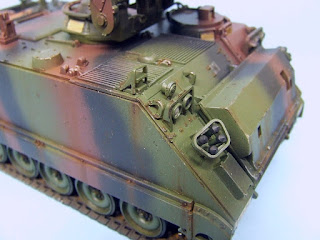When the weather has hit 112 F out there and you need AC and
fan in combination to get through the day, you don’t want heavy, complicated
projects, and knocking off some quick builds is the right medicine to break up
professional commitments.
I picked up Academy’s 1:72 F6F Hellcat (#2121) on eBay many
years ago and it has hung around on my shelves for the last two years or so with
some pre-painting done, therefore technically started. I would like to do a USN
midnight blue subject in each year, along with another from the grey-over-white
era, but my last blue was Academy’s F2H Banshee in 2015 – I was amazed to find
years had gone by since the last time I uncapped the blue! This Hellcat is a
surprisingly good little kit, very simple to put together (so long as you’re
careful with alignments, the wing to fuselage can bite you on the underside)
and has engraved detail so looks the part under a coat of paint.
Construction was not difficult, fit is generally okay,
though the engineering is not quite up there with the big guys. Options include
the small side panel windows to do the -3 variant, and you have bombs and
rockets for the -5. Clear parts are well done, with a choice of windscreens for
the two variants plus clear plug-in domes for the position lights on the spine
an tail light under the rudder. The engine is a decent little rendition of an
R-2800 and looks okay with a black wash. The prop shaft seems a bit thick and
profits from a swipe with a file. Landing gear is reasonably strong for the
scale, and undetailed gun barrels are moulded into the wing halves.
I’ve had disappointing results from commercial canopy masks,
they can pull up the paint as you remove them, and it’s frustrating indeed when
that happens as the product adds several dollars to the build cost. This time I
did it the old fashioned way, using thin-cut slivers of Tamiya tape and Gunze
masking fluid to outline and fill in the areas, and the thin braces are custom
decals – clear Superscale decal film oversprayed first with Interior Green,
then Midnight Blue, and finally Micro Satin. I made a piece 30 x 48 mm and
should be cutting strips from it for many years to come. I used my “Chopper”
mini guillotine to precision-cut a single strip, which provided the four short
pieces necessary (I didn’t get fancy with the 45-degree corners of the bracing
strips – tis is meant to be a simple project, after all).
I went with a mixed version of USN Midnight Blue (An 607/FS
25042), as I had read and agreed with the observation that Tamiya’s shade
(XF-17) was too dark. I tried the mixing ratio of XF-17 : XF-8 : XF-2 at 5:3:2,
this producing a slightly brighter and lighter blue. The original was not a
full gloss, so Microscale Satin was the perfect finish, right out of the
airbrush. I used the Academy instrument decal and going by the way it went on
the kit sheet would probably have been usable, but I intended from the start to
go with Superscales for this build, 72-737 being my choice, simple markings for
a -5 from an unidentified unit toward the end of the war.
The support straps running under the belly tank should be in
natural metal, and if I ever locate my silver strip decals I’ll add them.
Likewise with the bombs – lightened Olive Drab for scale effect, but the
ordnance decals I remembered turned out to be 1:48th scale, so if I
ever find smaller ones I may add them and perhaps a clear coat to dull down the
weapons. In the same spirit, when I get some superglue in a fresher state I’ll
look at adding a radio antenna, if I judge the mast strong enough to take the
mild but constant pull of EZline.
It came out very nicely and is my first Hellcat ever – I
built a Wildcat as a kid, if memory serves, but never its successor.
I can’t wait to get a Corsair into this mixed blue – it
looks better, to my eye, than any I’ve had out of a jar or can so far. Mind,
it’s a good job I wasn’t trying for a high gloss, or I’d have been very
disappointed, as I have yet to learn the trick of keeping dust and micro-fine hairs
out of the painting space.
Next up looks like being a Spit, and maybe a Phantom is
impending…
Cheers, Mike






















